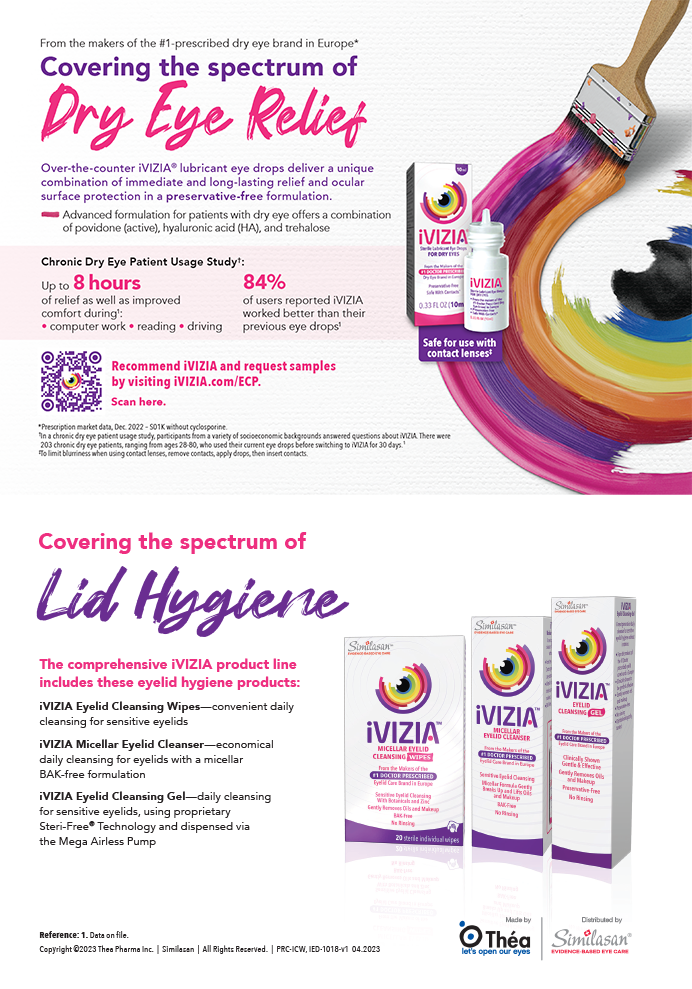Yes, the technology has increased my surgical safety and efficiency.
By Damien F. Goldberg, MD

The fundamental part of how ophthalmologists perform cataract surgery is the phaco machine. Because cataract surgeons are so successful, it may be hard for them to imagine that a new unit could be worthwhile, but there are advantages to having the latest technology. Upgrading to a new phaco machine has reduced my case time and the amount of ultrasound energy I use, and it has decreased my complications rate and my use of the vitrector.
FLUIDICS
To me, the Active Fluidics technology is the most important improvement offered by the Centurion Vision System (Alcon). With the Infiniti Vision System (Alcon), I relied on gravity and a bottle height of usually 75 to 90 cm to maintain IOP during surgery. The machine worked, but I still encountered a mismatch in internal eye pressure when the tip of the handpiece entered and exited the eye. This effect caused pressure surges in the eye as well as the occasional bounce of the posterior capsule, which increased the risk of posterior capsular tears and even a choroidal effusion. The reason for the changes in pressure was that the machine’s valves were designed either to open or close all the way.
The Active Fluidics technology significantly decreases sudden changes in pressure. First, the valve system was re-engineered so that the valves slowly rotate to an open or closed position in a twisting motion akin to unscrewing the top of a bottle. Second, the bottle of balanced salt solution (BSS; Alcon) no longer relies on gravity alone to maintain pressure; instead, an internal bag of BSS with pressure plates maintains constant pressure. Third, although the tubing that connects the handpiece is just as pliable as before, the smaller lumen of the tubing generates greater resistance. Fourth, the Centurion takes into account and adjusts for the position of the patient’s head, loss of irrigation, or fluid egress at the incision. In my experience, these improvements, taken together, generate a safer, more stable environment in which to perform phacoemulsification. I find that floppy irides are less likely to be disturbed, and I feel more confident going after stray nuclear fragments that may collect in the anterior chamber or on the iris.
THE PHACO TIP
In my hands, the Centurion’s Intrepid Balanced Tip delivers twice as much energy to the cataract as the Kelman tip while protecting the cornea at the incision site. The new handpiece is designed to decrease the risk of thermal burn and to break up the central part of the lens faster. Based on my experience, I do not expect my fellow surgeons to have trouble adapting to the technology, whether they favor divide and conquer or stop and chop.
VITRECTOMY
The vitrector on the Centurion has a speed of 4,000 cuts per minute compared with the 800 cuts per minute of the vitrector on the Infiniti. The result is faster and safer cleanup of vitreous. The new machine offers greater customization than the two choices of cut I/A or I/A cut mode. In addition, I can change cutting speed by altering how much pressure I apply to the foot pedal. Why is this helpful? My pedal is currently set so that I reach full cutting speed midway down. Pressing farther slows cutting to allow me to gain better purchase of the fragments that remain in the vitreous. For cortical cleanup, I frequently still choose I/A mode.
INTEGRATION
The Centurion is a part of Alcon’s surgical suite, so it integrates with the Verion Image Guided System, the LenSx Laser, and the Luxor LX3 Ophthalmic Microscope. Complete integration may not suit everyone, and not every surgeon will want to purchase all of these technologies. That said, full digital integration can reduce the human error associated with manually transferring information.
Damien F. Goldberg, MD
• private practice at Wolstan & Goldberg Eye Associates, Torrance, California
• (310) 543-2611; goldbed@hotmail.com; Twitter @damiengoldberg1
• financial disclosure: consultant to and clinical investigator for Alcon
No, financial realities mean new technology must offer substantial benefits, and the latest phaco machines do not.
By William J. Lahners, MD

Many ophthalmologists chose the specialty at least in part because of the incredible technology they use to improve the lives of their patients. Today, however, physicians face great financial pressure. Sure, I would like to have the latest technologies, but the realities of modern practice dictate that I carefully plan every purchase.
THE QUESTIONS TO ASK
The first question I ask when I see a new phaco machine is, “Is it really better?” The glossy brochure will describe technical advantages over the 10-year-old portables I use, so maybe the question should really be, “Will this device make me a better surgeon or deliver better results to patients than my current device?” Based on what I have seen, I would say that this is unlikely. Although power modulation has arguably been the biggest advance in phaco technology in the past decade, even my old system has it. Although my unit lacks torsional, elliptical, and hyperbolic disco movements, it works just fine. Plus, now that I am performing laser cataract surgery on more than two-thirds of my patients, am I not using less phacoemulsification anyway?
DISPOSABLES
It is not difficult to understand reasons manufacturers might only offer disposable tubing, packs, handpieces, and/or tips for the newest phaco machines. Nevertheless, I have not seen anything in the literature to support claims that disposables reduce the risk of infection, improve results, or are somehow better for patients unless they have a known history of prion disease. I have not seen one patient with this malady in my busy practice.
The waste generated by a single surgical case is astounding. I may not be the “greenest” person in the world, but even I am becoming more aware of my environmental footprint. As a society, people in the United States are going out of their way to reuse and recycle. Why, then, would I want to find more things that I can dispose of after a single use? Moreover, the financial pressures on ambulatory surgery centers are mounting. A careful look reveals a substantial difference between the cost of most reusable items versus that of disposable items. In an era of rapidly declining reimbursement, why would I want to adopt technology that reduces the profitability of my surgery center, especially if it does not improve patients’ care?
CONCLUSION
There are all sorts of marvels on which I can spend my hard-earned—and shrinking—resources. Does the technology pay for itself and perhaps even start its own revenue stream? Does it improve patients’ care or reduce complications? Can it be marketed? Does it enable me to perform procedures that I cannot currently and that are not covered? A new phaco machine does none of this. I will keep my old ones as long as I can.
William J. Lahners, MD
• medical director and director of laser vision services, Center for Sight, Sarasota, Florida
• (941) 925-2020; wjlahners@centerforsight.net


